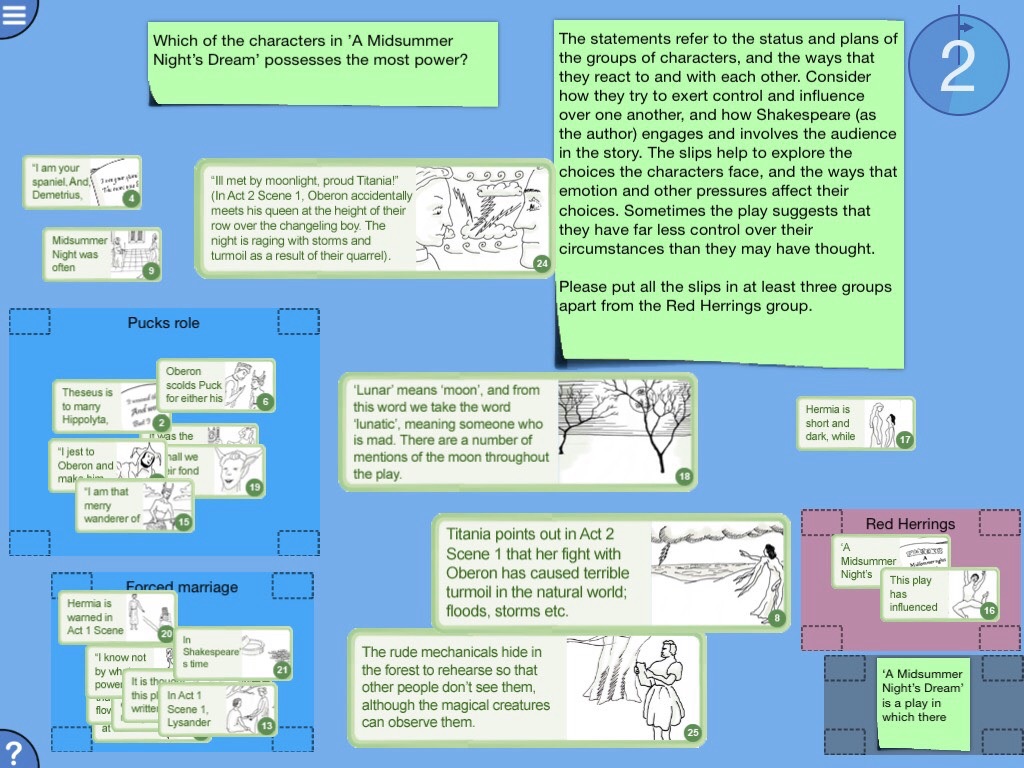
Midsummer Night's Dream (Engl)
This unique app allows pairs to work simultaneously on one iPad with a task designed to encourage discussion around the main question ‘Which of the characters in ’A Midsummer Night’s Dream’ possesses the most power?’
Users are given digital, illustrated slips on the play which include many direct quotations. They must read these, organise them into groups and then arrange into a sequence to represent their thought pattern in coming to an answer. The mystery is designed to help students explore relationships in the play and should help to address the assessment objectives that deal with writer’s purpose and use of language, and the structure of the text.
Following the process of solving the task, an automatic report with screenshots and information of the session can be shared or printed. Students can also go through the Reflection Stage in which they playback the process and reflect on their ideas. This can be done alone, with their group, with their teacher or even as a class. It is an excellent way to help develop higher level thinking skills, while at the same time, learning information crucial to the curriculum and exams.
The mystery comes with three difficulty settings. On easy, there are 18 slips, medium, 26 and hard, 33. At all levels, it can be used to explore the way the theme of love is presented and explored. Students are also encouraged to consider which of the characters have power over the others, and how – accordingly - control can be exerted and maintained. As the difficulty level increases, the added slips provide more information to help students focus on other elements too. An example from the medium level is how students can widen their analysis to cover how power can be manipulated and usurped. An example from the hard level is the way the extra slips introduce the ‘play within the play’ at the end of the story. This brings in an array of options to discuss and focus on, such as the ‘power’ that the playwright himself can wield upon the audience and its response to the performance.
Who is this app for?
Those age 11-16. By having three difficulty levels, it supports differentiation in class and can be suited to varying abilities/levels of knowledge. As the level goes up, more slips are added which bring in more complex discussion points and themes. There are also different sub questions suggested too which help teachers streamline the session to what theyd like students to focus on.
What is different about Digital Mysteries?
• Truly collaborative: It is unique in that more than one student can interact with it at once
• Retention: Working with information slips from two different perspectives (grouping, then fitting them into a sequence) ensures students remember more
• Higher-level thinking: The multiple discussion points, combined with the task’s open-ended nature, leads to students developing these skills
• Engagement: Mysteries split bulks of information into short snippets which makes it more digestible, plus working with peers leads to higher engagement levels
What does a mystery consist of?
• Illustrated slips: Including facts on the topic alongside story-based snippets about a particular character and their experiences
• Open question: To maximise the potential of discussion and expression of ideas, the nature of the task is usually open ended
• Extras: Most tasks come with personalised hints for those who need them. E.g. suggestions for grouping or sequencing their slips
• Description: This gives teachers the information they need to plan their session including the curriculum point each task links to, the advised age range and possible learning outcomes
How can I try other mysteries?
At the bottom of the app details tab, tap ‘Developer Apps’ to view our current range.



